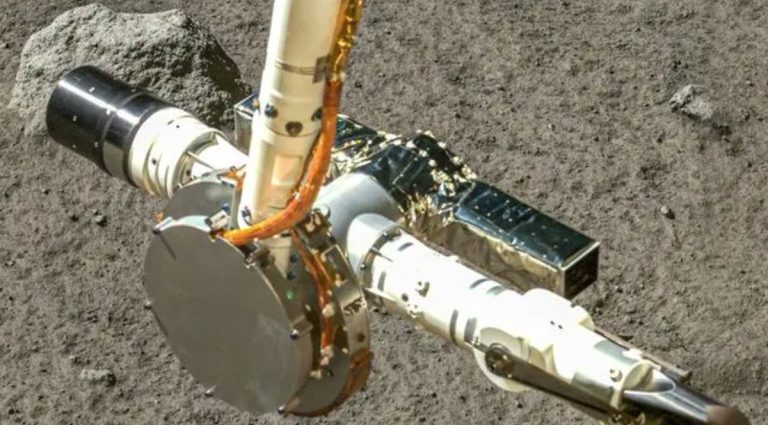The first Chinese rover on Mars may not be able to restart itself after a longer-than-expected hibernation since last May, according to the Planetary Exploration of China (or Tianwen), a program conducted by the China National Space Administration (CNSA).
Launched in the Tianwen 1 mission in July 2020, the Zhurong rover landed on the surface of Mars on May 15, 2021. It entered a sleep mode on May 18 last year to save power during the winter. It was supposed to wake up last December but it failed.
“Our analysis is that the rover has suffered from dust accumulation, which curbed its solar power generation ability, resulting in insufficient electricity to reboot itself,” said Zhang Rongqiao, chief designer of Planetary Exploration of China.
“When the dust accumulation on solar panels reaches 20%, the rover’s power generation ability declines,” Zhang said. “When it reaches 30%, the rover can generate power only if the sunlight is very strong. When it reaches 40%, it may not wake up again.”
He said Zhurong has already been operated on Mars for 358 sols (367 Earth days), beating its target of 90 days.

Tianwen 3, the next Mars mission of the Planetary Exploration of China, will be launched in 2028 and deliver samples to Earth in 2030 or 2031. If successful, it will be two to three years earlier than the National Aeronautics and Space Administration (NASA)’s Mars Sample Return campaign, which will bring rock samples to Earth in 2033.
According to the Tianwen 3 plan, the sample collector (landing-ascending combination) and deliverer (orbiter-returner combination) will be launched separately.
Sun Zezhou, chief designer of the Tianwen-1 mission, said the sample collector will depart in December 2028, land on Mars in September 2029 and launch the samples to Mars orbit in February 2030. He said the deliverer will depart in November 2028, arrive on Mars orbit in August 2029, receive the samples and bring them to Earth in November 2030.
In another plan he said, the sample collector will depart in May 2028, arrive on Mars in July 2030 and launch the samples to the planet’s orbit in October 2030. He said the deliverer will depart in December 2028, arrive on Mars orbit in September 2029, receive the samples and return to Earth in July 2031.
The second plan can help China’s rover avoid a sand storm between September 2029 and April 2030 on Mars.

Until now, Chinese scientists have not officially declared the retirement of Zhurong as there is still one last hope. They said it is possible that the rover will receive strong summer sunlight on July 8 and generate enough power to reboot itself.
Even if it cannot, it has already beat Sojourner, NASA’s first rover, which landed on Mars in July 1997 and operated for 92 sols (95 Earth days).
Zhurong traveled 1,921 meters on Mars while Sojourner ran about 100 meters.
NASA’s twin rovers, Opportunity and Spirit, landed on Mars separately in January 2004. Opportunity had surprisingly operated on Mars for more than 14 years and traveled 45.16 kilometers until it lost contact with Earth in August 2018.
Spirit had operated on the planet for more than six years and traveled 7.73 kilometers. It got stuck in a sand trap in late 2009 and ran out of power in March 2010.
NASA’s Curiosity and Perseverance rovers remain active on Mars. Landed in 2012, Curiosity has operated on the planet for more than a decade and traveled 29.27 kilometers.
Also launched in July 2020 as Zhurong, Perseverance has operated on Mars for more than two years and traveled 17.52 kilometers. Its mini-helicopter, Ingenuity, has already made 51 successful flights.

A Sichuan-based columnist says in an article published on Friday that it’s not possible that the Perseverance or Ingenuity can offer help to Zhurong.
“If Ingenuity can fly 51 times, can it help remove the dust on Zhurong’s solar panels?” the writer says. “Practically, it can’t. They are not in the same district.”
He says as Ingenuity has only flown for 10 kilometers, it can’t reach Zhurong, which is 1,800 kilometers away.
In comparison, the distance from the East Coast to West Coast of the US is about 1,958 kilometers.
While admitting the setback of the Chinese rover, Beijing also announced some good news about its Tianwen adventures earlier this week.
On Monday, CNSA and the Chinese Academy of Sciences jointly released a full image of Mars. They said the Tianwen 1 orbiter had taken 14,757 high-definition color pictures on the surface of the planet between November 2021 and July 2022.


They said the Paris-based International Astronomical Union has already approved the use of old Chinese village names to label 22 locations on Mars.
On Tuesday, a research team at the China University of Geosciences in Wuhan said the landform of Mars shows that there is water on the planet, probably in the form of ice at its two poles. It said the research has been published in Geophysical Research Letters, a scientific journal published by the American Geophysical Union.
CNSA also said this week that it has recently seen more progress for its Tianwen 2 mission, which will be launched in May 2025 to explore a co-orbital near-Earth asteroid 469219 Kao’oalewa or 2016H03, or the so-called Earth’s second moon.
Read: What do the moon and South China Sea have in common?
Follow Jeff Pao on Twitter at @jeffpao3

